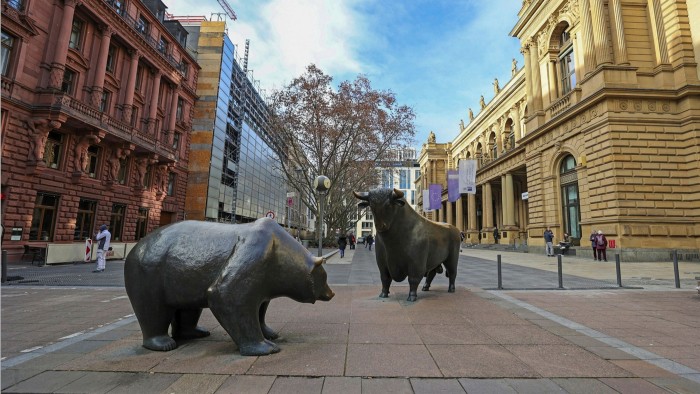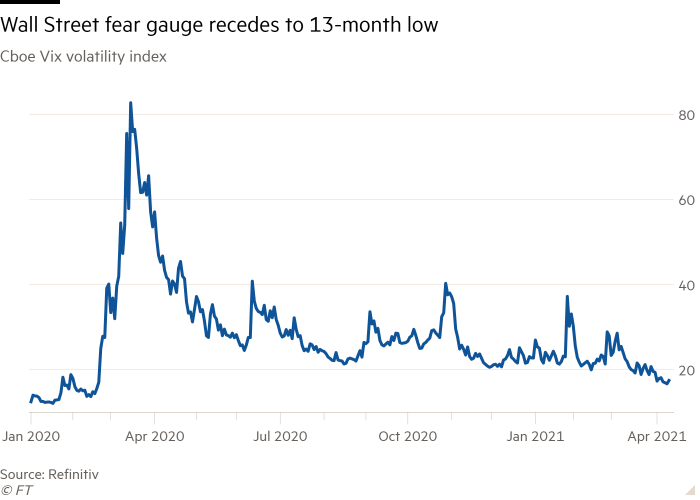Equities rally pauses ahead of US earnings season

Simply sign up to the Equities myFT Digest -- delivered directly to your inbox.
A stock market rally that sent equities to record highs last week paused on Monday as investors refrained from placing big bets ahead of the start of earnings season in the US.
The S&P 500, the blue-chip US share index, was less than 0.1 per cent lower, while the tech-heavy Nasdaq Composite slipped 0.4 per cent. In Europe, the Stoxx 600 equity benchmark closed down 0.5 per cent and the UK’s FTSE 100 fell 0.4 per cent.
The Cboe’s Vix index of US equity volatility, often referred to as Wall Street’s fear gauge, hovered near a 13-month low and trading volumes were substantially lighter than seen over the past month, Bloomberg data showed.
The S&P 500 and the Stoxx 600 hit record highs on Friday ahead of US quarterly earnings reports that are expected to show the strongest profit growth in two-and-a-half years as the economic recovery accelerates from the affects of the coronavirus. US banks JPMorgan, Goldman Sachs and Wells Fargo are scheduled to report earnings this week.
Analysts estimate overall earnings for the broad-based S&P 500 index of big US companies will rise 25 per cent in the first quarter compared with the same period last year. This would mark the biggest increase in profits since the third quarter of 2018, according to analysis by Credit Suisse.
Investors, however, remain wary. Companies’ outlook statements will be under scrutiny for clues about whether coronavirus curbs, a computer chip shortage and other supply chain logjams will hinder future earnings growth. The corporate tax rises that US president Joe Biden was lobbying for might also add pressure to record high valuations, analysts said.

“While policymakers have provided tremendous support for the economy with both monetary accommodation and fiscal stimulus, the lockdowns have reduced supply, destroying it in some cases,” said Mike Wilson, chief US equity strategist for Morgan Stanley. “Earnings season may bring bad news on costs and margins,” he added, particularly with respect to outlooks for the second quarter.
“Valuations are definitely a bit of a headwind,” said Supriya Menon, senior multi-asset strategist at Pictet. “The market for the rest of the year will definitely be driven by earnings growth rather than a rise in multiples sustained by liquidity,” she added. “And focus is turning to anticipated tax hikes and what they will mean for earnings for 2022 onwards.”
In fixed income, the US government bond market cleared two hurdles on Monday, following a $58bn sale of three-year Treasury notes and another $38bn auction of 10-year securities.
The first saw solid demand, with the Treasury offloading the shorter-dated debt at a yield of 0.376 per cent. Demand for the longer-dated benchmark bonds was more tepid, with investors demanding a slightly higher yield than prior to the sale, at 1.68 per cent.
The yield on the 10-year Treasury, which moves inversely to its price, was little changed following the auction. For the day, it was up 0.01 percentage points to 1.67 per cent from the close of trade on Friday.
The US government is set to sell $370bn of the debt this week, including the sales on Monday.
Treasury yields have risen sharply during 2021 as investors are poised for a jolt of inflation from Biden’s stimulus proposals. However, concerns about a ramp-up in bond sales were balanced by comments from Federal Reserve chair Jay Powell over the weekend that signalled no change to the central bank’s supportive monetary policies.
“Rising rates over time are generally not great for stocks,” said Mitch Rubin, the chief investment officer of RiverPark Funds. “But if the economy is strong and earnings are growth is fast, than that earnings growth may be more valuable to investors.”
The dollar, as measured against a basket of big currencies, slipped 0.1 per cent. Sterling rose 0.2 per cent against the dollar to purchase $1.374, while the euro was only marginally higher. Brent crude, the international oil benchmark, settled 0.5 per cent higher at $63.28 a barrel.
Additional reporting by Colby Smith
Comments